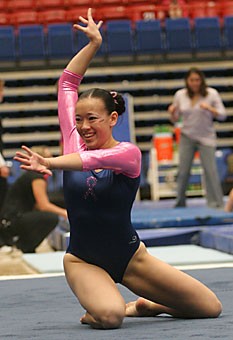Editor’s note: Ever watch gymnastics and have absolutely no clue who’s winning or what’s going on? Well, you will after reading the following explanation of scoring in collegiate gymnastics.
In a typical gymnastics meet, six gymnasts compete in each of the four events: vault, uneven bars, balance beam and floor exercise. The lowest score for each rotation is dropped, and the remaining scores make up the team score for that rotation. At the end of the meet, the four rotation scores are added together to determine the team’s total score.
The average of a team’s total scores determines the team’s NCAA ranking.
That’s why it’s so important that every gymnast hit every routine, said UA head coach Bill Ryden.
“”Gymnastics itself, through the club ranks and even out to the Olympics, is a very individual sport,”” Ryden said after Arizona’s defeat at UCLA Jan. 21. “”Here there is no individual. It’s all about the team score.””
The more-than-perfect 10
All gymnasts strive for a 10 – the highest score a routine can achieve – but for most the 10 is elusive.
Sure, a few gymnasts have done it. Eight former Arizona gymnasts scored a perfect 10 on at least one event, and 2000 graduate Heidi Hornbeek and 2002 graduate Randi Liljenquist each had two career 10s. But only four NCAA gymnasts have ever recorded a perfect 10 on all four events, and most never get any.
Not all routines are even worth 10 points. Each routine is assigned a start value based on the elements the gymnast performs. Each skill has a certain point value assigned by the NCAA depending on its difficulty.
As a gymnast performs, two judges record each skill as it is completed. At the end of the routine, each judge adds up the elements and assigns the routine a score, and the average between the two scores makes up the final score as it is assigned to the gymnast.
Although a routine can’t technically have a start value higher than 10, many routines are loaded with extra skills in case a gymnast misses a skill or a judge doesn’t see something, Ryden said.
“”Most of our routines start higher than a 10.0 if you were actually to add up all the 10ths,”” he said. “”They’re sort of like insurance 10ths.””
And even a 10th of a point can make a big difference to the final score.
That’s because in a gymnastics routine everything counts, and even the slightest mistake can result in a deduction. Tiny errors like balance checks, stepping on a landing and even pausing too long between skills can add up quickly. Form breaks – like if a gymnast doesn’t straighten her legs, point her feet or fully extend her position in the air – can also bring the score down. Deductions can even be applied if the routine doesn’t have enough variety.
And falling off an apparatus or falling on a landing can be deadly to the team’s score. As soon as a gymnast falls, she receives an automatic 0.5 deduction, and often her start value will drop because she didn’t complete a key skill.
“”I think with gymnastics, you can always do something better,”” said Arizona senior Aubrey Kelly.
Kelly said there have been times when she felt like her routine was perfect down to the last detail, but she still didn’t achieve the high score she would have liked. But that just gives her an extra drive for the next competition, so that “”basically I just don’t give them an opportunity to score me low again.””
There are many factors that go into a routine’s score besides its skills, Kelly said.
“”How you present yourself, what your skills look like, your overall dynamics – even making a name for yourself is definitely a factor,”” she said. “”The people that have that whole package on the event are the ones that are going to come out with a perfect 10.””
Choreography is key
Although a floor routine’s dance elements and presentation don’t explicitly factor into the score, they can affect the overall impression a gymnast leaves on a judge.
Arizona senior Jamie Holton, for example, uses physical expression and musical timing to her advantage, Ryden said.
“”It’s such a nice routine the judges almost forget to be judging,”” he said. “”Jamie Holton’s routine isn’t as hard as some of our other routines. But just the way she does it and the way she performs, it’s like you forget she’s doing a floor routine.””
Arizona assistant coach Colleen Johnson, who choreographs all the team’s floor routines, said she takes each gymnast’s personal style into consideration when putting a routine together.
Some gymnasts who have more dance training, like Holton and Kelly, pitch in their own ideas as well, resulting in a personalized routine that shows off a particular gymnast’s strengths.
“”In college you tend to have these trademark-type things that you repeat year after year, no matter what the routine is,”” said Holton, whose routine shows off her flexibility with split leaps and deep backbends.
Even the way an athlete uses her face can make an impression on the judges, Johnson said. For that reason, the team holds a “”floor performance”” the day before every meet when the gymnasts practice the choreography without any of their tumbling skills – and they have to make eye contact with all of their teammates.
“”If someone just sits on the floor, looking down, it’s not exciting, it’s not vibrant, it’s not dynamic,”” Johnson said. “”You’ve got to take into account that the judges are human beings. Anyone can be influenced by performance.””









